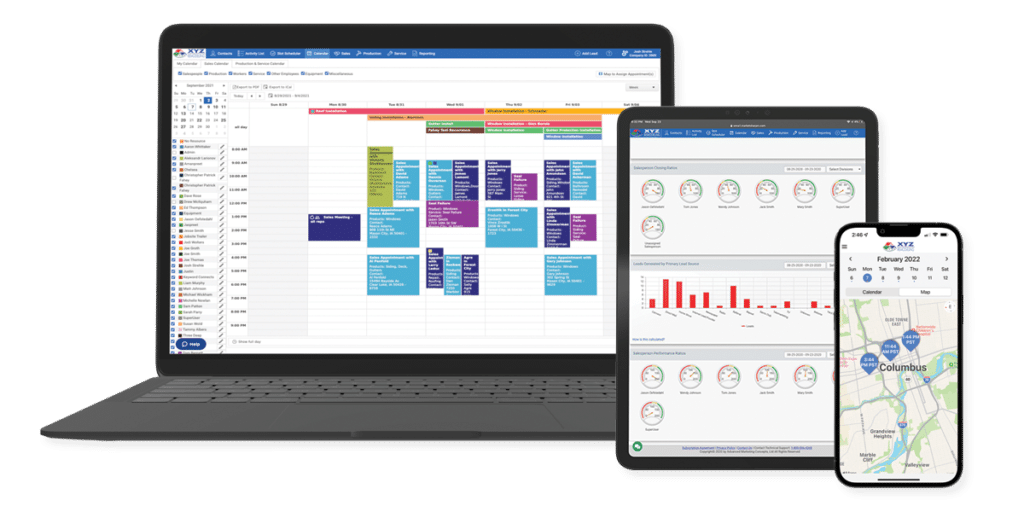Home services providers are experts in helping homeowners. But while you unquestionably know your trade, you may not be as familiar with how to grow a service-based business.
by Simone Toth, Staff Contributor at Inside Advisor Pro
Home services providers are experts in helping homeowners. That’s your bread and butter. But while you know your trade, you may not be as familiar with how to grow your business. The good news? You can leverage your hard-earned expertise in unexpected ways. For example, follow the tips below to turn your company into the go-to home services provider in your area.
But first things first: Determining what growth means to you can help you choose which path of business growth you want to follow. From there, you can create a strategy to achieve your goals. In this article, we’ll define the different types of business growth to choose from. We’ll also look at how each path might fit your business goals. From growing your customer base to increasing your profits without increasing your company size, you’ll learn the steps to success.
Types of Business Growth
Growing a service-based business can vary for each business owner. It all depends on the type of business growth you desire. When determining the goals for your business, it’s important to understand exactly what you’re after.
You can grow your business by:
- Growing your operations and customer base
- Improving profitability without increasing company size
- Stabilizing the company through better efficiency (without growing in size or profits)
1. Grow Your Company with New Customers
When most business owners think about growth, the first thought that comes to mind is finding new customers. If this is the type of growth you’re looking for, it’s important to have the right team and equipment. Without both, you might not be able to handle the extra work that comes with more customers.
Here are some ideas on how to grow your company by attracting new customers and turning them into loyal brand advocates.

Create Buyer Personas
Start by identifying your ideal customer. Your existing customers’ demographic characteristics can give you a clear idea about who your target audience may be. Consider things like income level, interests, and pain points. Look for commonalities in your customer information. Then, create an identifying label for each group. This makes it easier to target your ads and other marketing efforts to their interests.
You can use these insights to create buyer personas, which help you better understand the customers you are trying to reach. For example, let’s say you have a plumbing business. You learn that many of your customers are stay-at-home partners of busy professionals. In your conversations with these customers, you realize they have little knowledge about plumbing. Plus, they have trouble scheduling work because of their partners’ schedules. They want a company that responds quickly and has flexible scheduling.
You can use these insights to categorize those types of customers into one persona. You may also get another large chunk of your business from general contractors. They hire you to install plumbing systems in new homes and commercial buildings. They trust you as a dependable specialist in your field. So, they call you first when they have a new project.
These customers fall into a different buyer persona. Their pain points and needs are different than others. Getting creative with your buyer personas allows you to laser-focus on your target customers’ needs. Then, you can use the personas to cater your marketing efforts to their specific needs.
Create High-Value Content to Build Authority and Trust
Once you’ve developed your buyer personas, you can start creating content for them. This content should be helpful, answer questions, and offer solutions. For example, you can write a blog article with step-by-step instructions on how to use a plumber’s snake to unclog a stubborn drain. This will offer value to someone searching for that information.
It also positions you as a helpful expert. Or, you can write an article about new developments in plumbing technology that can save time and money. Potential customers reading your articles will know you’re current on industry trends. That enhances your brand value and authority. Each of these pieces should focus on the types of things your customers might search for. The best way to do that is by targeting specific keywords that interest your potential customers. For example, a homeowner may search for companies to install a tile floor or how to do it themselves.
You can incorporate keywords into a blog article about how to install a tile floor. These keywords—coupled with an article that offers value to the reader with helpful tips—can help your SEO (Search Engine Optimization). SEO is the process of improving your website so that it ranks higher on search engines. The best way to do this is by offering valuable information to readers. For a more in-depth discussion on how to use SEO to grow your business, check out this article.
If you have a team member who enjoys writing, you can leverage their skills for blog articles. If there’s no writer in the house, you could try a video version instead. Video content is an effective way to convey your expertise. Video is so effective that 81% of marketers who use videos report an increase in revenue. No matter what type of content you produce, content marketing is a cost-efficient and effective way to build your customer base.
2. Improve Profitability Without Increasing Your Company’s Size
If you can’t find qualified candidates (or you just don’t have the money to hire), you can still grow your company. There are ways to increase your profitability with your current team. Here are several ideas for growing your bottom line while maintaining your current size.
Promote New Services to Existing Customers
Your chances of selling services to someone who’s already purchased from you are better than 60%. This highlights the benefit of marketing to customers you already have. You can increase profits from your existing customer base by doing the following:
Upsell Customers
As a home services professional, the need for your services may not be limited to a one-time call. While you may first meet a customer due to a specific problem, there is a chance they will need more services in the future. While on your first visit, or after the transaction, you can offer more products or services by upselling.
For example, if you are fixing a clogged air duct in an HVAC system, it would be important for the customer to have regular system servicing in the future. You can offer routine air filter replacement and servicing for an additional cost. This will help to increase your profits and improve the customer relationship.
Bundle Services
If you provide regular services, such as opening a pool at the beginning of a season or closing it at the end, you can bundle services into a package. Create a package that offers this service along with maintenance throughout the summer. By bundling these services, the customer saves by avoiding damage before it happens, and you get a source of recurring income.
Bundling your services also helps improve the longevity of your customer relationship. The longer they stay with you, the more loyal they will be to your business. They’ll probably recommend you to friends and neighbors, and can provide positive online reviews, which strengthens your reputation in the community.
Offer Free Inspections and Estimates to Existing Customers
One way to suggest other services to current customers is to offer free annual inspections. Your customers will appreciate the effort to prevent potential issues, and you could land some new sales in the process.
3. Cut Costs Without Compromising Quality
Having a firm handle on your operations costs despite changing fuel and raw material prices can be a challenge for any business owner. It can be tempting to try to lower costs by finding cheaper materials or less experienced employees. But it’s important to remember that your customers expect high-quality services. Instead of taking the cheap route, try some of these ideas to help reduce expenses while maintaining your quality of work.
Outsource Support Services
The employees who perform the services you offer are critical. Hire the best and keep them happy with outstanding support, fair wages, and team spirit. You may be able to save on expenses by outsourcing support services, including marketing, accounting, administrative personnel, and human resources.
Source Local Materials
With today’s technology, you can automate many of your support services. Start by researching platforms that help you automate parts of your process such as scheduling, handling routine customer service issues, and receiving customer feedback.
Streamline the Customer Experience
With today’s technology, you can automate many of your support services. Start by researching platforms that help you automate parts of your process such as scheduling, handling routine customer service issues, and receiving customer feedback.
4. Calculate Your Clients’ Customer Lifetime Value
It’s important to identify which customers will bring in the most revenue over time and how much value they bring to your business. Customer lifetime value (CLV) measures how much a customer is worth to your business throughout the entirety of the business relationship. Your CLV can help you identify the most valuable customers and determine where your profits are coming from.
You’ll also learn how much it costs you to get a new customer and maximize the value of existing customers. This data will help you make more informed decisions about your business operations and marketing efforts by highlighting where you can both spend and save money.

Calculate this data by finding your customer value (CV), then multiplying it by your average customer lifespan. Here’s how:
- Determine the average purchase (Average Purchase Value, or APV) a specific type of customer (maybe one of your personas) makes.
- Note the average number of purchases (Average Number of Purchases, or ANP) these customers make.
- Calculate how long these types of customers typically do business with you (their Average Customer Lifespan, or ACL).
You can calculate each customer’s value with this equation: CV = APV x ANP
Then, calculate your customer’s lifetime value using the following equation: CLV = CV x ACL
Once you have your CLV, you can determine how much revenue to expect from each given customer during their relationship with your business.
Knowing this helps you:
- Identify and segment the categories of customers that are most valuable to you.
- Determine ways to increase your CLV like upselling and bundle packages.
- Reduce spending on acquiring new customers by nurturing existing relationships.
5. Solidify Your Company’s Stability with More Efficient Operations
Of course, your growth goal could be as simple as stabilizing your business. Not everyone is trying to make more money or build an empire. If that’s the case for you, here are a few ways to get started:
Consider Specializing in a Niche
Find a specialized area in which you excel can help build your reputation as an expert in that niche market. For instance, if you’re a plumber, you could specialize in toilet repairs or detecting hidden pipe leaks. Or, if you’re a stonemason, you could focus on building world-class fireplaces.
Do the Job Right the First Time
Make quality work your top priority. That way, you won’t need to waste time on costly re-dos. Inspire your teams to take on the same work ethic, so no matter who performs the work, it will be first-rate.
Commit Yourself to Continual Improvement
Find better, more efficient ways to perform your work. Whether it’s better accuracy or more finishing touches to your work, always be watching for ways to improve your work.
Arrive on Time, Every Time
No one wants to wait around for a home services professional to arrive. Make it your pledge to arrive when you promised and finish on time. Your reputation as a dependable service provider will soar.
The Best Way to Grow Your Business
Which strategy is the best? That depends on you and your goals. After all, we’re talking about your business. No matter how you choose to grow your service-based business, you should keep these tips on hand for reference. As your company changes over the years, your growth strategy may need to change, too.
Now that you have a better understanding of what business growth means, here are the next steps you can take:
- Create at least three buyer personas for your business. For each persona, think about what it will take to work with more of these kinds of homeowners.
- Talk to your field techs about reselling and upselling opportunities. Make sure they know how other products and services could be sold to the homeowners they’re helping.
- Calculate the CLV for each of the three personas you’ve developed. Then, consider ways you can win over more of the folks who tend to spend the most with you.
- Brainstorm with your sales and field tech managers to determine ways you can improve customer satisfaction. Focus on ideas that are low-cost to you that make for a more pleasant customer experience.
Learn More About MarketSharp
The all-in-one, software solution for home service professionals looking to automate their business with industry-specific workflows and end-to-end tools, with easy-to-use features and out-of-the-box value.


